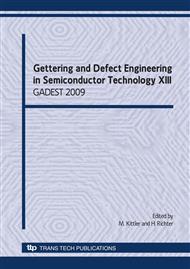p.61
p.69
p.77
p.85
p.91
p.95
p.101
p.107
p.115
Buried Insulating Layer Formation in Cz Si Wafers after Helium Implantation, Nitrogen Plasma Treatment and Annealing
Abstract:
Standard p-type 12 cm Cz Si wafers were implanted by helium ions. The implanted and nonimplanted samples were subsequently subjected to nitrogen plasma treatment and final vacuum annealing. SEM studies have shown the absence of large-scale defects on the top wafer surface and the presence of a layer revealing contrast with surrounding silicon on the cleavage surface at a depth corresponding to the projected range Rp. Scanning over a crater formed by ion sputtering has exposed no defects to the depth of Rp and beyond. At the same time, at a depth of Rp there is a layer with the morphology (structure) significantly different from the surrounding defect-free areas. The measurements of transverse conductivity have shown that the wafer with the formed nitrogen-contained layer possesses dielectric properties with a breakdown voltage up to 15 V.
Info:
Periodical:
Pages:
91-94
Citation:
Online since:
October 2009
Authors:
Keywords:
Price:
Сopyright:
© 2010 Trans Tech Publications Ltd. All Rights Reserved
Share:
Citation:


